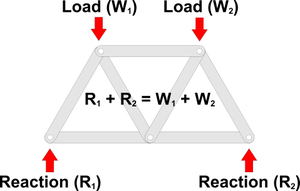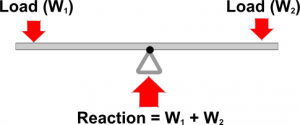Equilibrium: Difference between revisions
From DT Online
m (Added Category) |
mNo edit summary |
||
| (One intermediate revision by the same user not shown) | |||
| Line 1: | Line 1: | ||
[[File:BeamEquilibrium.png|300px|right]] | [[File:BeamEquilibrium.png|300px|right]] | ||
The study of forces in '''Beams''', '''Frames''', '''Bridges''' and other '''Structures''' comes under the general heading of [ | The study of forces in '''Beams''', '''Frames''', '''Bridges''' and other '''Structures''' comes under the general heading of [http://en.wikipedia.org/wiki/Statics '''Statics'''] - this is concerned with things that either stay still ''(i.e. are at '''rest''')'' or stay in the same relative position to each other as they move with constant velocity ''(e.g. as they rotate with the Earth)''. | ||
| Line 9: | Line 9: | ||
For an object to remain fixed in this way, forces acting on it must cancel each other out ''(e.g. all downward forces must be equalled by upward forces)''. When in this condition the object is said to be in '''Equilibrium'''. For a beam or a bridge to stay anchored to the spot, all forces or loads acting down on it must be resisted by equal and opposite | For an object to remain fixed in this way, forces acting on it must cancel each other out ''(e.g. all downward forces must be equalled by upward forces)''. When in this condition the object is said to be in '''Equilibrium'''. For a beam or a bridge to stay anchored to the spot, all forces or loads acting down on it must be resisted by equal and opposite '''[[Reactions (structures)|Reactions]]''' to these forces acting upwards - see [http://en.wikipedia.org/wiki/Newton's_laws_of_motion '''Newton's First Law of Motion'''] | ||
Latest revision as of 08:04, 31 March 2017
The study of forces in Beams, Frames, Bridges and other Structures comes under the general heading of Statics - this is concerned with things that either stay still (i.e. are at rest) or stay in the same relative position to each other as they move with constant velocity (e.g. as they rotate with the Earth).
For an object to remain fixed in this way, forces acting on it must cancel each other out (e.g. all downward forces must be equalled by upward forces). When in this condition the object is said to be in Equilibrium. For a beam or a bridge to stay anchored to the spot, all forces or loads acting down on it must be resisted by equal and opposite Reactions to these forces acting upwards - see Newton's First Law of Motion
A See-Saw can be made to balance, or remain in Equilibrium, if the person sitting on one side, tending to make it turn clockwise, exerts exactly the same force as the person on the other side tending to make it turn anti-clockwise. In addition, the central support must be able to resist the total load exerted by both.


